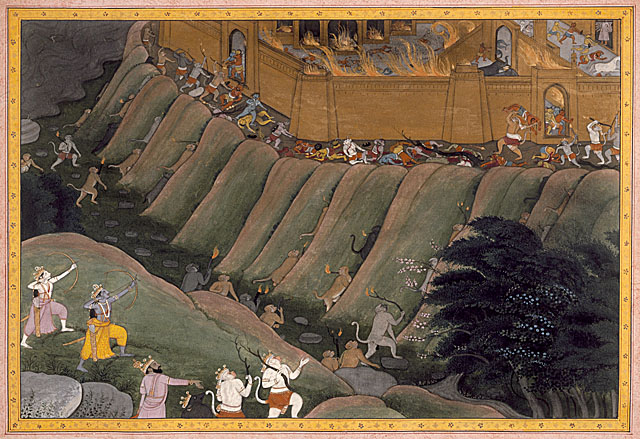
School: Boston College High School
Project Title: Ashrama, Dharma, Moksha: The Ramayana as a Metanarrative for Hindu Cosmology
|
Amidst greed and desire (embodied in Ravana, for example) there is an order of actions that must be fulfilled. Karma begets karma (good actions~good results) which explains Rama’s moral "consistency” in which he serves as a model of leadership, a paradigm for behavior as a prince but also as a human being. Duty is rooted in one’s social place (ashrama) despite a karma which may promoted behavior that one “wants” to do. Karma may refer to the general category of behavior which may or may not reinforce one’s moral obligations (NB: this often becomes translated in the western mindset as “bad karma,” referring to an corollary between one’s behavior toward others and how this is reflected in how one is treated by others). In Hinduism, one is almost encouraged to embrace physical and materialistic pleasures (kama and artha, respectively)—this is the Path of Desire. Additionally, positions of power and authority are also encouraged but these are ultimately limited since power is transitory. Thus for Hinduism, the pursuits of the body and social stature are insignificant since they do not enagage how one should be acting toward others and the world. The shift occurs when one first discovers that duty (dharma) is fulfilling, that by serving others one discovers our true nature. The next step finds its place beyond the physical realm in moksha, the liberation from the wheel of samsara. These are both known as the Path of Renunciation.
In the Ramayana, there is a seemingly infinite regress of characters’ behavior and their respective dharma—What if the king refused to fulfill Kaiteka’s boons? What if Rama didn’t chase the golden deer? What is Soorpanaka did not pursue Rama? What if Ravana gave back Sita? These often direct our reading to many of the moral dilemmas found in the Ramayana which are often the subject of scrutiny in academic journals. For example, where person A has dharma A then how does one explain why s/he performs action B? One of the notable vignette’s of this incongruity is the disfiguring of Soorpanaka by Rama (in other traditions, Lakshmana commits the action). Much can be said about the role of dharma in the Ramayana since many of the figures stand as paradigms for right behavior in Indian society (e.g., “be like Rama/Sita” is a common phrase children hear growing up). Rama models the ideal son, king and husband; Sita as the ideal wife (though there are several feminist critiques of this often passive depiction of her); Bharata and Lakshmana as ideal brothers of service; and the unassuming love of devotion by Hanuman. From a different perspective, Ravana is the ideal of amoral behavior in the hubris exhibited by his lust for Sita and power (the path of desire) which lead to his eventual demise. As a result, there is the tangible tension between desires and obligations in the Ramayana which speak to the Path of Desire & Renunciation where the latter satiates human nature.
|
This site was created by Patrick Tiernan at the NEH Summer Institute "Cultures and Religions of the Himalayan Region," held at the College of the Holy Cross, Summer 2006
